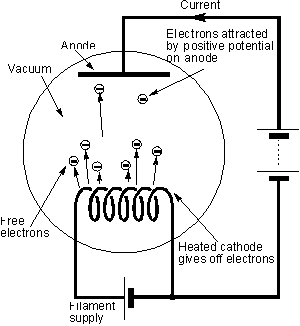Thermionic or vacuum tubes all operatte using thermionic emission of electrons from a heated cathode.

The vacuumu tube consists of two electrodes: a cathode and anode held within an evacuated glass bulb, connected to an external circuit.
If a cathode is heated, it is found that electrons from the cathode become increasingly active and as the temperature increases they can actually leave the cathode and enter the surrounding space.
In a diode vacuum tube there is also another electrode called the anode. If a positive potential is applied to the anode, the electrons will be attracted by this potential and will move towards it if it is at a higher potential than the cathode.
For the optimum performance the space between the cathode and the anode should be a vacuum. Any atoms in the tube will will impede the flow of electrons.
The cathode will be surrounded by a cloud of negatively charge atoms forming a 'space charge'.As the voltage of the anode is increased ,the current increases until the space change is completely neutralised and emission from the cathode is maximised. The rate of emission can only be increased by increasing the cathode temperature, increasing the energy of the electrons and allowing further electrons to leave the cathode.
If the anode potential is reversed, and made negative with respect to the cathode it will repel the electrons. No electrons will be emitted from the anode as it is not hot, and no current flows. Current can only flow in one direction. The valve is acting as a diode.
It was discovered that if a further electrode was placed between the cathode and the anode, the current could A n electrode known as a grid, a thin mesh or wire through which the electrons could pass s used. The grid is normally placed at a voltage below that of the cathode, repelling the electrons. If the voltage on the grid is varied the current can be controlled. The tube is acting as an amplifier.
